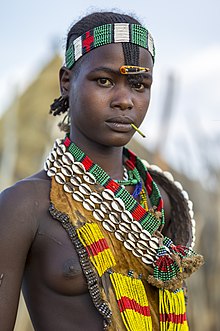Hamarstammen
Hamarstammen (Hamer) er et samfund ved Omo-floden i sydvestlige Etiopien. Den bor i Hamer woreda (eller distrikt), en frodig del af Omo-flodedalen i Debub Omo Zonen i Southern Nations, Nationalities og Peoples Region (SNNPR).
Levebrød
De er kvæg-nomader, og deres kultur lægger stor vægt på kvæget.
Uddannelse
Den assisterende administrator af Hamer Bena, Ato Imnet Gashab, har fortalt, at kun seks stammeledere nogensinde har afsluttet en gymnasial uddannelse.
Befolkning
Den nationale folketælling i 2007 talte 46.532 medlemmer af Hamarstammen; de 957 boede i byer. Langt hovedparten (99,13%) bor i SNNPR.
Skikke
Som led i manddomsprøver skal en ung mand løbe over en række af køer. Men inden da skal han forbi store grupper af kvinder, som hopper og danser mens de blæser på trompeter, så køerne bliver bange. Kvinderne har lange pinde til at piske den unge mand til blods, så han kan få store smukke ar på ryggen.
|
Medier brugt på denne side
Forfatter/Opretter: Alfred Weidinger from Vienna, Austria, Licens: CC BY 2.0
Hamer are one of the most known tribes in southwestern Ethiopia. They inhabit the territory east of the Omo river and have villages in Turmi and Dimeka. They are a semi-nomadic, pastoral people, numbering about 40,000. There is a division of labour in terms of sex and age. The women and girls grow crops (the staple is sorghum, alongside beans, maize and pumpkins). They’re also responsible for collecting water, doing the cooking and looking after the children – who start helping the family by herding the goats from around the age of eight. The Hamar only marry members of their own tribe, but they have nothing against borrowing – songs, hairstyles, even names – from other tribes in the valley like the Nyangatom and the Dassanech. Girls tend to marry at about 17.
Forfatter/Opretter: Irina Kazanskaya from Moscow, Russia, Licens: CC BY 2.0
Khanty girls



